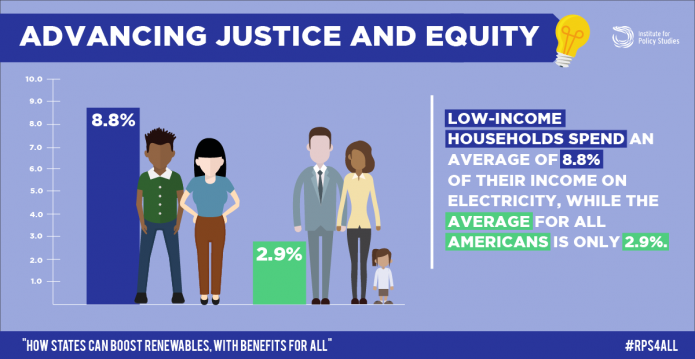Given the current assault on responsible climate policy at the federal level, innovative state and local actions will be critical if we are to transition to a sustainable economy with much less racial and economic inequality and greater public control.
A new Institute for Policy Studies report, “How States Can Boost Renewables With Benefits for All,” focuses in on one strategy for a just transition: Renewable Portfolio Standards (RPS). RPS require utilities to provide a growing share of electricity from solar and wind energy, and are a particularly promising policy option — especially if they increase the benefits of a clean energy transition for low-income families.
Twenty-nine states and the District of Columbia already have RPS requirements, and eight other states have voluntary renewable energy goals. Building on this progress — by enacting RPS in additional states, tightening current standards, and making voluntary programs binding — would have significant environmental, economic, and social benefits.
Much of the growth in residential solar energy in recent decades has largely benefited white, middle class families. Increasing solar access for low-income households is an equity issue because it removes barriers to participation for populations who have not benefited much from renewable energy but have often borne the brunt of fossil fuel extraction and pollution. Low-income households spend an average of 8.8% of their income on electricity, while the average for all Americans is only 2.9%.
A 2015 study estimates that a typical set of residential solar panels would meet more than half of an average low-income household’s electricity needs. Low-income households are disproportionately African-American and Latino, and hence advancing income- and race-conscious policies for renewables will also advance racial justice.
Effective renewables programs also have the potential for significant creation of good jobs. Solar energy accounted for 43% of U.S. employment in electric power generation in 2015, even though it represented only 2.2% of generation capacity. Similarly, wind energy represented 11.8% of power generation jobs but only 6.8% of generating capacity.
These figures suggest that solar and wind energy growth through expanded RPS and increased low-income solar access would create many more jobs than a business-as-usual energy model. Renewable energy jobs are also comparable in wages to fossil fuel jobs. A typical wind turbine technician, for example, earns $25.50 per hour, significantly more than several categories of fossil fuel occupations.
Another benefit of these programs is that they would reduce our economy’s dependence on centralized power generation and distribution by large corporate utilities. The total U.S. electricity market was worth $391 billion in 2015. By giving families and small businesses a stake in an expanded renewable energy market, these policies would keep more of this money in communities.
The report concludes by identifying key “best practice” elements of RPS and low-income solar access policies, drawing from successful state models.

